Nuclear submarines with ballistic missiles of the Leninist type. Project 667-A "Navaga" (Yankee-I class)
In 1961, they began to develop a new layout in which the D-4 (D-6) missiles were to be located in vertical mines. But soon these complexes received a good alternative - a single-stage small-sized liquid ballistic missile R-27, the work on which was led by VP Makeev began in SKB-385 on an initiative basis. At the end of 1961, preliminary research results were reported to the country's leadership and the naval command fleet. The topic was supported, and on April 24, 1962, a government decree was signed on the development of the D-5 complex with R-27 missiles. Thanks to some original technical solutions, the new ballistic missile was “squeezed” into the mine, which is 21 times smaller than the R-2,5 mine. At the same time, the R-27 missile had a launch range of 1180 kilometers greater than that of its predecessor. Also a revolutionary innovation was the development of technology for refueling rocket tanks with fuel components, followed by their amplification at the manufacturing plant.
As a result of the reorientation of the 667 project to the new missile system, it became possible to place the 16 rocket mines vertically in the robust hull of the 5 submarine (as was done by the American George Washington-type ballistic missile submarine). However, sixteen rocket ammunition was caused not by a desire for plagiarism, but by the fact that the length of the stocks intended for the construction of submarines was optimally suited to the hull with sixteen D-667 mines. The chief designer of an improved nuclear submarine with a BR of the XNUMX-A project (the code “Navaga” was assigned) - Kovalev S.N. - The creator of almost all Soviet strategic missile nuclear submarines, the main observer from the Navy - Captain First Rank MS Fadeev.
When creating a submarine project 667-A, much attention was paid to the hydrodynamic perfection of the submarine. Specialists from scientific industry centers and hydrodynamics of the central aerohydrodynamic institute were involved in the development of the vessel's form The increase in rocket ammunition required the solution of a number of problems. First of all, it was necessary to sharply increase the firing speed in order to have time to produce the rocket volley and leave the launch area before the anti-submarine forces of the enemy arrive at it. This led to the conduct pre-launch simultaneous preparation of missiles that are recruited in the volley. The task can be solved only by automating the start-up operations. For ships of the project 667-A in accordance with these requirements under the guidance of the chief designer Belsky R.R. work was started on the creation of the first Soviet information-controlling automated system “Tucha”. For the first time, the data for firing should have been developed. COMPUTER. Navigation equipment of the submarine was supposed to provide confident sailing and launching of missiles in the areas of the poles.
The submarine of the 667-A project, like the submarines of the first generation, was a double-hull (the reserve of buoyancy was 29%). The bow of the vessel was oval. In the stern, the submarine was spindle shaped. On the fencing of the felling was located the front horizontal rudders. This solution, which was borrowed from American nuclear submarines, created the possibility of a non-differential transition at low speeds to a greater depth, and also simplified the retention of the submarine during a rocket volley at a predetermined depth. Aft plumage - cruciform.
The robust housing with outer frames had a cylindrical section and a relatively large diameter, which reached 9,4 meters. Basically, the robust housing was made of AK-29 steel with millimeter 40 thickness and was divided into 10 compartments with watertight bulkheads that withstood the 10 pressure kgf / sq.cm:
first compartment - torpedo;
the second compartment - residential (with officers' cabins) and battery;
the third compartment is the central post and console of the main power plant;
the fourth and fifth compartments are missile;
the sixth compartment - diesel generator;
the seventh compartment is the reactor compartment;
the eighth compartment - the turbine;
the ninth compartment - the turbine;
The tenth compartment served to accommodate electric motors.
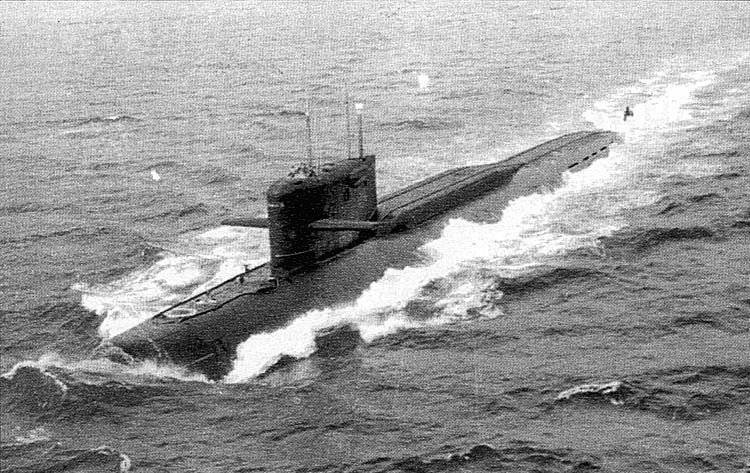
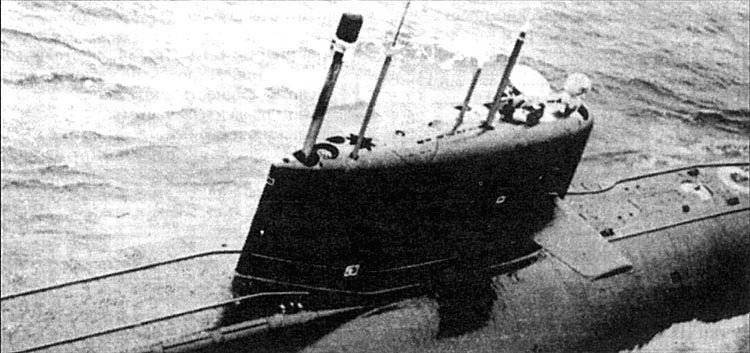
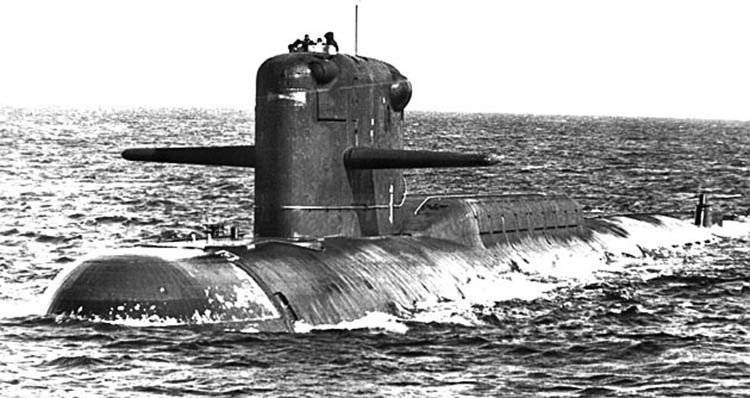
Frames durable hull made of welded symmetrical T-shaped profiles. An 12 mm AK-29 steel was used for inter-partition bulkheads. For lightweight body used steel SW.
A powerful demagnetizing device was installed on the submarine, which ensured the stability of the magnetic field. Also, measures were taken aimed at reducing the magnetic field of the lightweight body, durable external tanks, protruding parts, rudders and fencing of sliding devices. To reduce the electric field of the submarine for the first time applied the active field compensation system, which was created by a galvanic pair of "screw-case".
The main power plant rated power 52 ths. Liters. with. included a pair of autonomous units of the right and left sides. Each unit consisted of a BM-2-4 water / water reactor (89,2 power, mW), a OK-700 steam turbine unit with a turbo-gear unit TZA-635, and an independent drive turbo generator. In addition, there was an auxiliary power plant, which serves to cool down and launch the main power plant, supplying the submarine with electrical energy in case of accidents and providing, if necessary, the movement of the vessel in the surface position. The auxiliary power plant consisted of two DG-460 diesel direct-current generators, two groups of lead-acid rechargeable batteries (each with 112 el. 48-CM) and two reversing propeller stalling motors PG-153 (power of each 225 kW) . On the day when the main SSBN of the 667-A project was put into service (the chief designer of the project was among the others on board, the maximum speed reached 28,3 nodes, which exceeded the set speed at the 3,3 node. Thus, according to its dynamic characteristics, the new missile carrier actually became equal to the main potential opponents in the “underwater duels” - anti-nuclear Sturgeon and Treshcher nuclear submarines (30 units) of the US Navy.
Two propellers compared to nuclear submarines of the previous generation had a lower noise level. In order to reduce hydroacoustic visibility, foundations under the main and auxiliary mechanisms were covered with vibration-damping rubber. The soundproof rubber was lined with a durable submarine hull, and the lightweight hull was covered with a non-resonant anti-hydrolocation and sound-insulating rubber coating.
On the submarine of the 667-A project, for the first time, an alternating-current electric power system with a voltage of 380В was used, which was powered only by independent electric generators. Thus, the reliability of the electric power system was increased, the duration of work without maintenance and repair increased, and also it was possible to transform the voltage to supply different users of the submarine.
The submarine cruiser was equipped with the “Tucha” combat information and control system (BIU). "Tucha" was the first Soviet multi-purpose automated ship system, providing the use of torpedo and rocket weapons. In addition, this CICS collected and processed information about the environment and solved navigation problems. To prevent failure to a great depth that could lead to a catastrophe (according to experts, this caused the death of the Trecher nuclear submarine of the US Navy) for the first time the 667-A SSBN implemented an integrated automated control system providing programmed depth and course control of the vessel. also stabilization in depth without stroke.
The main information tool of the submarine in a submerged position was the SJC "Kerch", which served to illuminate the underwater situation, issuing target information, torpedo firing, min search, detection of hydroacoustic signals and communications. The station was developed under the direction of the chief designer Magid M.M. and worked in the modes of noise and echo. Detection range from 1 to 20 th. M.
Communications equipment - ultrashortwave, shortwave and medium wave radios. The boats were equipped with an exhaust pop-up ADD-buoy-type antenna “Paravan”, which allowed receiving signals from a satellite navigation system and targeting, at depths less than 50 meters. An important innovation was the use (on submarines for the first time in the world) of ZAS equipment (communication secrecy). When using this system, automatic encryption of messages that were transmitted via the Integral line was provided. The electronic armament consisted of the defendant radar "friend-foe" Khrom-KM (installed on a submarine for the first time), the search radar Zaliv-P and the radar Albatros.
The main armament of the 667-A nuclear-powered submarine with ballistic missiles consisted of X-NUMX liquid P-16 single-stage ballistic missiles (ind. GRAU 27K4, the western designation - SS-N-10 "Serb", according to the OSP contract - PCM-6), SSM-25 SSM-2,5), the SSM-14,2 SSM-1500 "Serb", the Western designation, SSM-9650 650 thous. Km, installed in two rows in vertical shafts behind logging fences. The launch weight of the rocket is 1,3 thousand kg, diameter is 1 mm length is 1700 mm. The mass of the head part is 10100 kg, the circular probable deviation is XNUMX thousand m, the power of XNUMX Mt. Rocket shafts with a diameter of XNUMX mm, height XNUMX mm, made equal power with the hull of the submarine, located in the fifth and fourth compartments. In order to prevent accidents in the event that the components of the liquid fuel enter the mine during the depressurization of the rocket, automated systems for gas analysis, irrigation and maintaining the microclimate in the given parameters were installed.
The missiles were launched from submerged mines, exclusively in the submarine of a submarine, with an excitement of the sea less than 5 points. Initially, the launch was carried out in four consecutive four-rocket volleys. The interval between launches in the salvo was equal to 8 seconds: calculations showed that the submarine should gradually emerge as the missiles are fired, and after the launch of the last, fourth, rocket - to leave the “corridor” of the starting depths. After each volley it was necessary about three minutes to return the submarine to its original depth. Between the second and third salvo, 20-35 minutes were needed to transfer water from the annular gap tanks to the missile shafts. This time has also been used to trim the submarine. But the real shooting revealed the possibility of the first eight-missile salvo. Such a volley for the first time in the world performed 19 December 1969 of the year. The size of the firing sector of the submarine project 667-A was equal to 20 degrees, the launch point width should be less than 85 degrees.
Torpedo armament - four nasal 533-millimeter torpedo tubes, providing the maximum depth of firing to 100 meters, two nasal torpedo tubes of 400 mm caliber with a maximum depth of firing 250 meters. Torpedo tubes had systems of electrical remote control and fast loading.
The submarines of the 667-A project were the first missile carriers to receive the Strela-2М type MANPADS (portable anti-aircraft missile system), which is designed to defend a floating vessel from helicopters and low-flying aircraft.
In the 667-A project, considerable attention was paid to habitability issues. Each compartment was equipped with an autonomous air conditioning system. In addition, they implemented a number of measures to reduce acoustic noise in residential premises and at combat stations. The personnel of the submarine was located in small cabins or cabins. On the ship was an officer's mess room. For the first time on the submarine was provided for dining room for officers, quickly transforming into a cinema or gym. In residential premises, all communications were removed under removable specials. panels. In general, the internal design of the submarine complied with the requirements of the time.
The new missile carriers in the fleet began to be referred to as SSBN (strategic missile submarine cruiser), which emphasized the difference between the data of submarines and SSBNs of the 658 project. The power and size of the boat made a huge impression on the sailors, because earlier they dealt only with “diesel engines” or significantly “less solid” first-generation submarines. The undoubted advantage of the new ships in comparison with the ships of the 658 project, in the opinion of the sailors, was a high level of comfort: the “industrial” colorful interiors with interlacing of pipelines and colored harness gave way to the thoughtful design of light gray tones. Incandescent bulbs have been replaced with fluorescent lights "in vogue".
For appearance resemblance to American nuclear submarines with ballistic missiles "George Washington" new missile carriers in the fleet dubbed "Vanki Washington." In NATO and the United States they were given the name Yankee class.
Modifications of the project 667-A.
The first four nuclear submarines with ballistic missiles of the 667-A project were equipped with the ones developed in 1960 under the leadership of Maslevsky V.I. All-latitude Sigma navigation complex. From 1972, the Tobol navigation complex began to be installed on submarines (Kishchenkov O.V., Chief Designer), consisting of an inertial navigation system (for the first time in the Soviet Union), an absolute hydroacoustic lag that measured the speed of a vessel relative to the seabed, and a system information processing, built on a digital computer. The complex provided confident navigation in the Arctic waters and the possibility of making a rocket launch at latitudes up to 85 degrees. The equipment determined and maintained the course, measured the speed of the submarine relative to the water, made up the geographic coordinates with the issuance of the necessary data to the ship’s ship systems. On the submarines of the last building, the navigation complex was supplemented with a “Cyclone” - a space navigation system.
Submarines of later construction had automated Molniya radio communication systems (1970 year) or Molniya-L (1974 year), the head of these developments was AA Leonov, Chief Designer. The complexes consisted of an automated Basalt radio receiver (provided reception on a single SDL channel and several KB channels) and a Mackerel radio transmitting device (allowed to perform a hidden auto tune to any of the operating frequency frequencies).
The introduction of the Polaris A-3 advanced missiles into service with the US Navy (maximum range of 4,6 ths. Km) and the launch of the Poseidon C-1966 ballistic missile, which has higher characteristics, in 3 required to respond to increasing the potential of Soviet nuclear submarines with ballistic missiles. The main focus of work was equipping submarines with more advanced missiles with an increased range of fire. The development of the missile system for the upgraded submarines of the 667-A project was undertaken by the Arsenal design bureau (the 5MT project). These works led to the creation of the D-11 complex with the ballistic solid-fuel missiles of the P-31 submarines. The D-11 complex was installed at K-140 - the only SSBN of the 667-AM project (re-equipment was carried out in 1971-1976). In the West, this boat was given the designation Yankee II class.
At the same time, an upgraded D-5U complex for P-27U missiles with a range of up to 3 thousand km was developed in KBM. 10 June 1971, a government decree was issued, which provided for the modernization of the D-5 missile system. The first pilot launches from the submarine began in 1972. The D-5 04.01.1974 complex was adopted by the Navy. The new P-27U missile (in the West, under the designation SS-N-6 Mod2 / 3), in addition to the increased range, had a conventional single-piece head or an improved head of a “dissipative” type, having three combat units (power of each 200 Kt) without an individual system guidance The 31 Division at the end of 1972 received the K-245 submarine, the first submarine of the 667-AU project, with the D-5U missile system. From September 1972 to August 1973, tests were performed on P-27U. All 16 launches from the K-245 submarine were successful. At the same time, the last two launches made at the end of combat service from the combat patrol area (the Tobol navigation system with an inertial navigation system was tested on the same submarine, and at the end of 1972 of the year, the submarine performed a hike to the equator to check the capabilities of the complex). In the period from 1972 to 1983, the fleet also received 8 SSBNs (K-219, K-228, K-241, K-430, K-436, K-444, K-446 and K-451), completed or upgraded to the 667-AU project (“Burbot”).
K-411 was the first nuclear-powered ballistic missile submarine of the 667-A project, withdrawn from the strategic nuclear forces as a result of the US-Soviet arms reduction agreements. In this relatively “young” submarine, in January-April 1978, the missile compartments were “amputated” (subsequently disposed of), and the 09774 missile submarine itself was converted into a special-purpose atomic submarine, the carrier of the ultra-small submarine and combat swimmers.
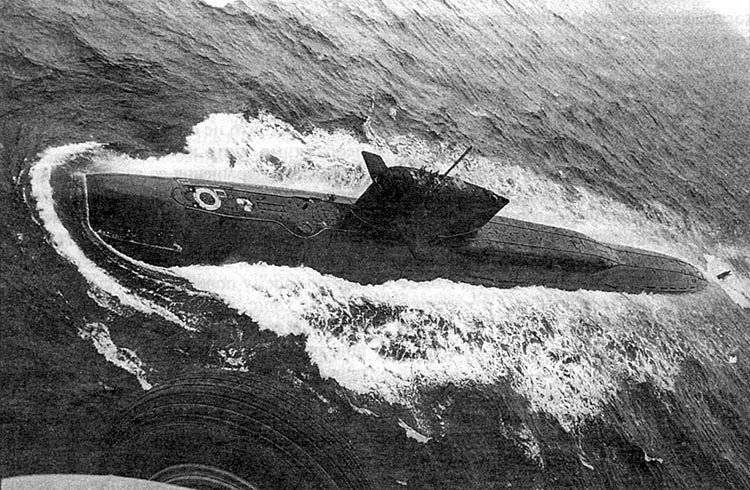
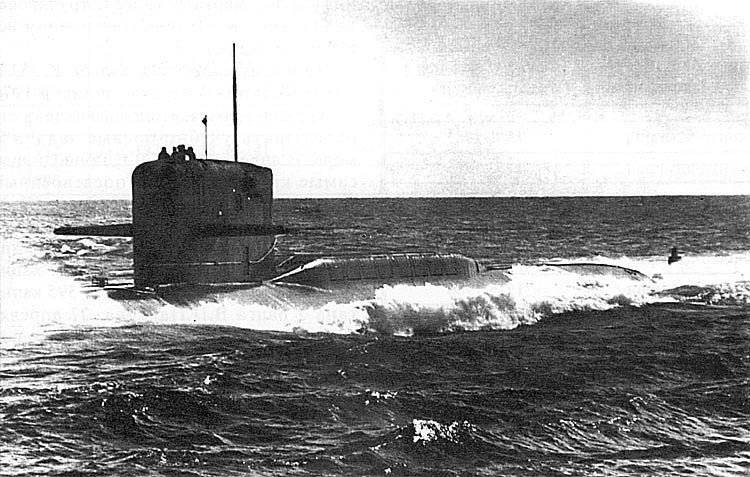
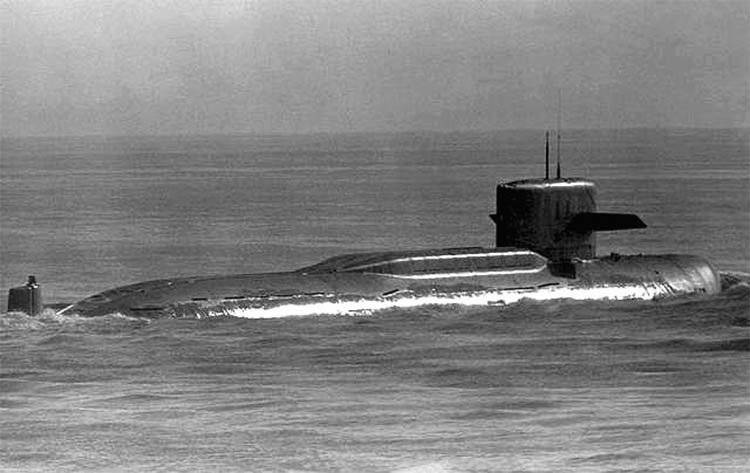
The special purpose boat for the 667-AK project (Axon-1), and later for the 09780 project (Axon-2), was transformed into the K-403 rocket carrier. In the experimental order for this submarine installed specials. and powerful GAK with a towed extended antenna in the fairing on the tail plumage.
In 1981-82, K-420 SSBNs were upgraded under the 667-M (Andromeda) project to test the high-speed strategic Thunder GD (Meteorit-M) developed by OKB-52. The 1989 tests of the year failed, so the program was minimized.
Another five vessels of the 667-A project were to be re-equipped according to the 667-AT (“Pear”) project into large torpedo nuclear submarines carrying subsonic small-sized CGM “Granat”, by adding an additional compartment having onboard torpedo tubes. Under this project, four submarines were refitted at 1982-91. Of these, only the atomic submarine K-395 remained in the ranks so far.
The construction program.
Construction of submarines on the project 667-A began at the end of 1964 in Severodvinsk and was carried out at a rapid pace. K-137 - the first SSBN laid at the Northern Machine-Building Plant (CVD No. XXUMX) 402. Launching, or rather, filling the dock with water, took place 09.11.1964. On K-28.08.1966 on 137, the September 14 watches raised a naval flag. At the same time, acceptance tests began. K-1 137 entered service. The new missile carrier commanded by Captain First Rank Berezovsky VL December 05.11.1967 arrived in the thirty-first division, based in Yagelnaya Bay. The submarine 11 November was transferred to the nineteenth division, becoming the first ship of this division. 24 into service with the Navy adopted the D-13.03.1968 missile system with the P-5 missiles.
The Northern Fleet was quickly replenished with second generation "Severodvinsk" missile carriers. The K-140 - the second boat of the series - was put into service 30.12.1967. It was followed by another 22 SSBN. Somewhat later, construction began on the 667-A submarines in Komsomolsk-on-Amur. K-399 - the first "Far Eastern" nuclear-powered ship - joined the Pacific Fleet 24.12.1969. In the future, this fleet consisted of 10 SSBNs of this project. The last Severodvinsk submarines were completed under the improved project 667-AU with the D-5U missile systems. The entire series of submarines of the 667-A and 667-AU projects, built between 1967 and 1974, amounted to 34 of the vessel.
Status on 2005 year.
As part of the Northern Fleet ships of the project 667-A were part of the nineteenth and thirty-first divisions. The service of new nuclear submarines did not start very smoothly: the numerous “childhood diseases” that were natural for such a complex complex. So, for example, during the first launch of the K-140 - the second ship of the series - the left-side reactor was out of service. However, the cruiser under the command of Captain First Rank Matveeva A.P. successfully completed the 47-diurnal campaign, part of which took place under the ice of Greenland. There were also other troubles. However, gradually, as the equipment was mastered by the personnel and its “refinement”, the reliability of the submarines increased significantly, and they were able to realize their capabilities, unique for that time.
K-140 in the fall of 1969 was the first in the world to launch an eight-rocket salvo. The two thirty-first division missile carriers, the K-253 and the K-395, took part in the largest naval maneuvers Okean in April-May 1970. During them, rocket launches were also made.
Nuclear-powered submarine with ballistic missiles K-408, commanded by Captain First Rank V.V. in the period from January 8 to March 19, the 1971 of the year made the most difficult transition from the SF to the Pacific Fleet without ascent to the surface position. 3-9 March during the march, the submarine performed combat patrols off the US coast. The campaign was headed by Rear Admiral Chernavin V.N.
August X-NUMX rocket carrier K-31 under the command of the captain of the first rank S. Sobolevsky, (the senior on board is Rear-Admiral GL Nevolin), for the first time equipped with an experienced special. equipment detection of stains in the ice and polynya, reached the North Pole. The submarine maneuvered for several hours in search of a polynya, but none of the two discovered was suitable for ascent. Therefore, the submarine returned to the edge of the ice to meet with the icebreaker waiting for her. The report on the implementation of the task due to poor radio signal transmission was transmitted to the General Staff only through the Tu-411РЦ aircraft patrolling above the ascent point (when returning this aircraft crashed while landing at the Kipelovo airfield because of thick fog; the crew of the aircraft - a 95 man - died ). K-12 in 415 completed a successful transition under the Arctic ice to Kamchatka.
Initially, the SSBN, like the ships of the 658 project, carried combat duty around the east coast of North America. However, this made them more vulnerable to the increasingly powerful American anti-submarine weapons, which included the underwater observation GAS, specialized nuclear submarines, surface ships, as well as coastal and ship-based helicopters and airplanes. Gradually, with an increase in the number of submarines of the 667 project, they began to patrol around the Pacific coast of the United Shtotov.
The 31 Division at the end of 1972 received the K-245 submarine, the first submarine of the 667-AU project, with the D-5U missile system. In September, 1972 - August 1973, during the development of the complex was tested rocket R-27U. The 16 launches made from the K-245 submarine were successful. In this case, the last two launches made at the end of combat service from the area of combat patrols. Also on the K-245 tested Tobol navigation system having an inertial system. At the end of 1972, the submarine made a trip to the equatorial region to test the capabilities of the complex.
K-444 (project 667-AU) in 1974 year carried out rocket firing without ascent to the periscope depth and from a fixed position, using the depth stabilizer.
The high activity of the American and Soviet fleets during the Cold War many times led to the collision of submarines that were underwater during latent observation of each other. In May, the 1974 of the year in Petropavlovsk near the base of the navy one of the submarines of the 667-A project, which was located at a depth of 65 meters, collided with the Pintado nuclear submarine (type “Sturgeon”, SSN-672) of the US Navy. As a result, both submarines received minor damage.
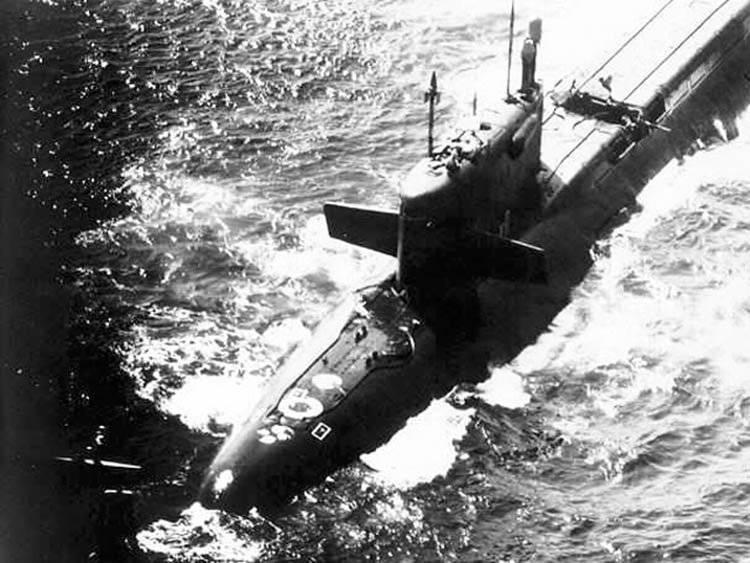
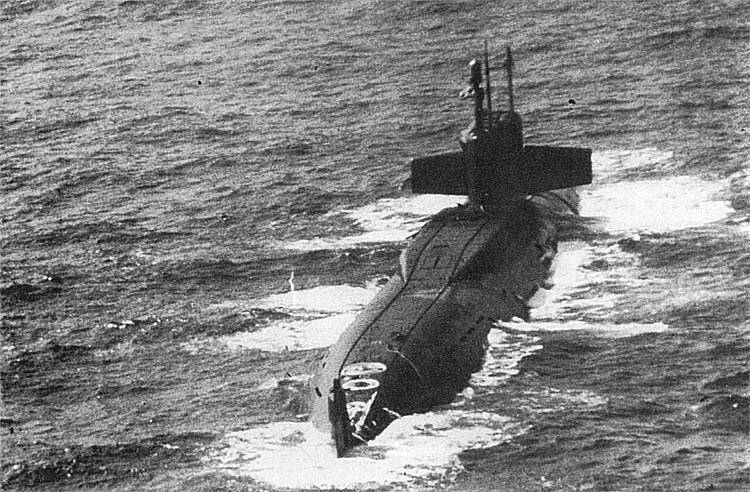
6 October 1986 The K-219 submarine during combat service was lost in 600 miles from Bermuda. On a nuclear submarine with a BR K-219 (commander captain second rank Britanov I.), who was in combat service near the east coast of the United States, a missile missile fuel was released, followed by an explosion. After the heroic 15-hour battle for survivability, the crew was forced to leave the submarine due to the rapid entry into a solid hull of water and a fire in the holds of the fourth and fifth compartments. The boat sank at a depth of 5 thousand m, carrying with them 15 nuclear missiles and two nuclear reactors. During the accident, two people died. One of them, sailor Preminin SA at the cost of his own life, he shut down the starboard reactor manually, thereby preventing a nuclear catastrophe. He was posthumously awarded the Order of the Red Star, and 07,07.1997 was awarded the title of Hero of the Russian Federation by decree of the President of the Russian Federation.
Over the entire period of operation, missile submarines of 667-A and 667-AU projects carried out 590 combat patrols.
At the end of the 1970s, in accordance with the Soviet-American agreements on arms reduction, submarines of the 667-A and 667-AU projects began to be removed from the composition of the Soviet strategic nuclear forces. The first two submarines of these projects were launched for conservation (with a cut-out of the missile compartment) in 1979. Subsequently, the withdrawal process accelerated, and in the second half of 1990, not a single missile carrier of this project remained in the Russian Navy, except for the K-395 667-AT project, converted into a carrier of cruise missiles and two special purpose submarines.
The main tactical and technical characteristics of the submarine project 667-A "Navaga":
Surface displacement - 7766 tons;
Underwater displacement - 11500 tons;
The greatest length (on KVL) - 127,9 m (n / d);
The greatest width - 11,7 m;
Draft on KVL - 7,9 m;
Main power plant:
- 2 WWR type BM-2-4, the total capacity of 89,2 mW;
- 2 PPU OK-700, 2 GTSA-635;
- 2 steam turbines, total power 40 thousand hp (29,4 thous. KW);
- 2 turbogenerator OK-2А, hp 3000 power;
- 2 diesel generator DG-460, power of each 460 kW;
- 2 ED of the economic course PG-153, power 225 kW;
- 2 shaft;
- 2 five-bladed propellers.
Surface speed - 15 nodes;
Submerged travel speed - 28 nodes;
Immersion depth - 320 m;
Extreme depth of immersion - 550 m;
Autonomy - 70 days;
Crew - 114 man;
Strategic missile weapons - 16 SLBM launchers R-27 / R-27U (SS-N-7 mod.1/2/3 "Serb") of the D-5 / D-5U complex;
Anti-aircraft missile armament - 2 ... 4 PU PUZRK 9K32M "Strela-2M" (SA-7 "Grail");
Torpedo armament:
- 533-mm torpedo tubes - 4 nasal;
- 533 mm torpedoes - 12 pcs;
- 400-mm torpedo tubes - 2 nasal;
- 400 mm torpedoes - 4 pcs;
Mines - 24 mines instead of torpedoes;
Electronic weapons:
Combat information and control system - "Cloud";
Radar general detection system - “Albatross” (Snoop Tray);
Hydroacoustic system - Kerch hydroacoustic complex (Shark Teeth; Mouse Roar);
Means of electronic warfare - "Zaliv-P" ("Kalina", "Blueberry-1", "Luga", "Panorama-VK", "Vizir-59", "Cherry", "Paddle") (Brick Pulp / Group; Park Lamp D / F);
GPD tools - 4 GPD MG-44;
Navigation complex:
- “Tobol” or “Sigma-667”;
- CNS "Cyclone-B" (recent modifications);
- radio textant (Code Eye);
- ins;
Radio communication complex:
- “Lightning-L” (Pert Spring);
- towed buoy antenna "Paravan" (ADD);
- VHF and HF radio stations ("Depth", "Range", "Quickness", "Shark");
- station of underwater communication;
Radar of state recognition - "Chrome-KM".
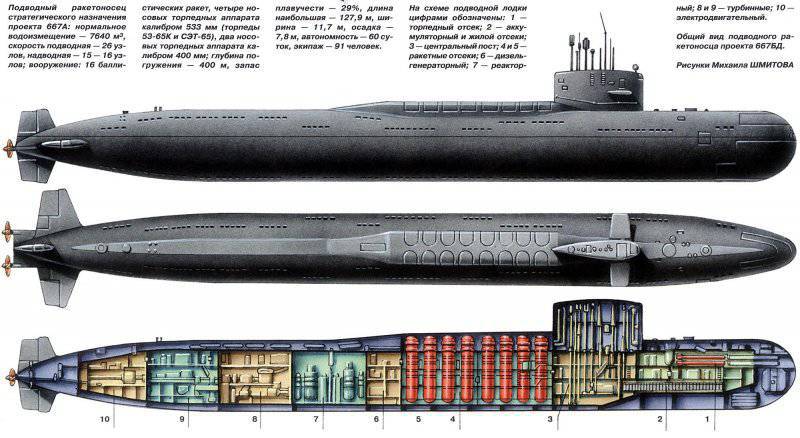
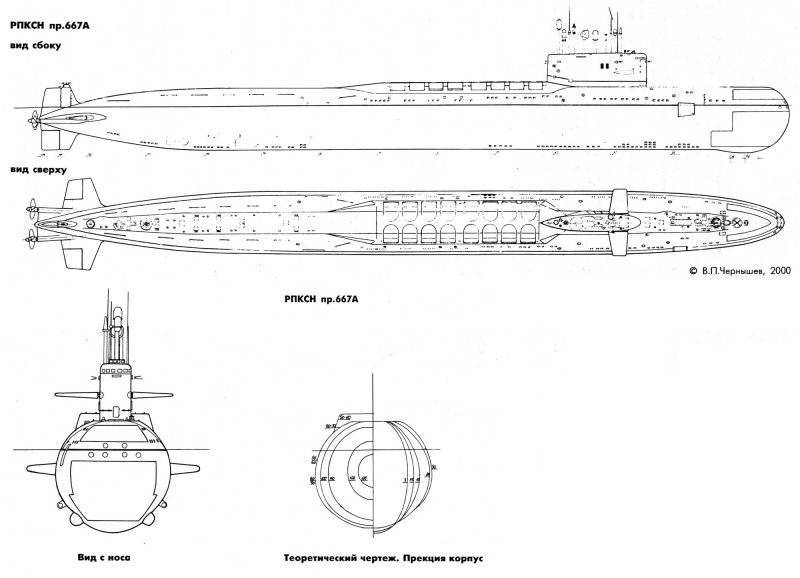
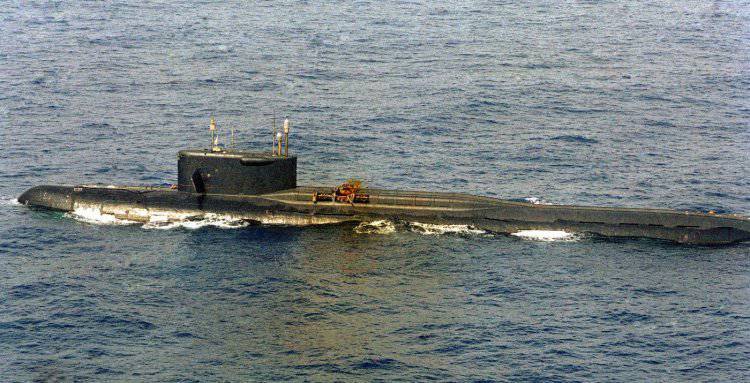
Information